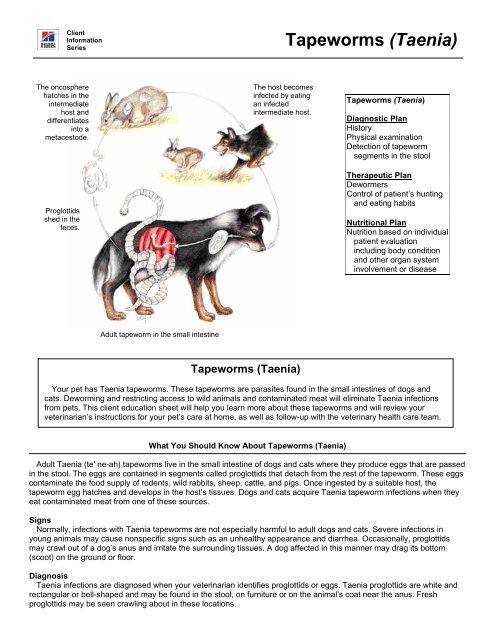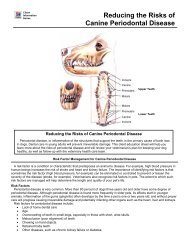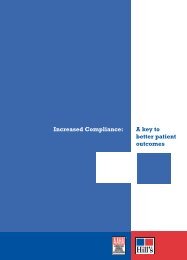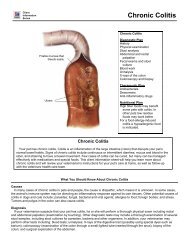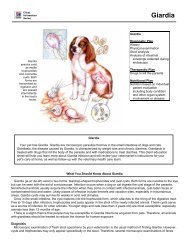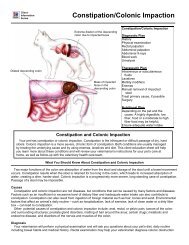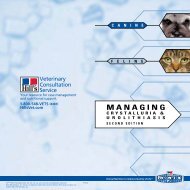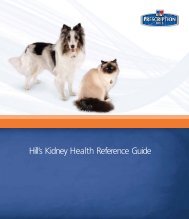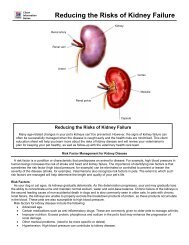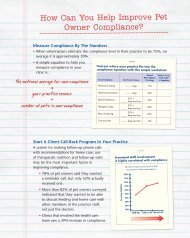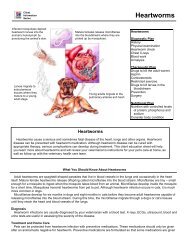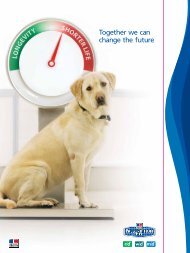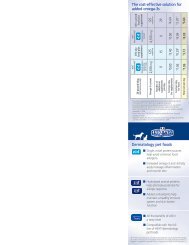Tapeworms (Taenia) - HillsVet
Tapeworms (Taenia) - HillsVet
Tapeworms (Taenia) - HillsVet
Create successful ePaper yourself
Turn your PDF publications into a flip-book with our unique Google optimized e-Paper software.
Client<br />
Information<br />
Series<br />
<strong>Tapeworms</strong> (<strong>Taenia</strong>)<br />
The oncosphere<br />
hatches in the<br />
intermediate<br />
host and<br />
differentiates<br />
into a<br />
metacestode.<br />
Proglottids<br />
shed in the<br />
feces.<br />
The host becomes<br />
infected by eating<br />
an infected<br />
intermediate host.<br />
<strong>Tapeworms</strong> (<strong>Taenia</strong>)<br />
Diagnostic Plan<br />
History<br />
Physical examination<br />
Detection of tapeworm<br />
segments in the stool<br />
Therapeutic Plan<br />
Dewormers<br />
Control of patient’s hunting<br />
and eating habits<br />
Nutritional Plan<br />
Nutrition based on individual<br />
patient evaluation<br />
including body condition<br />
and other organ system<br />
involvement or disease<br />
Adult tapeworm in the small intestine<br />
<strong>Tapeworms</strong> (<strong>Taenia</strong>)<br />
Your pet has <strong>Taenia</strong> tapeworms. These tapeworms are parasites found in the small intestines of dogs and<br />
cats. Deworming and restricting access to wild animals and contaminated meat will eliminate <strong>Taenia</strong> infections<br />
from pets. This client education sheet will help you learn more about these tapeworms and will review your<br />
veterinarian’s instructions for your pet’s care at home, as well as follow-up with the veterinary health care team.<br />
What You Should Know About <strong>Tapeworms</strong> (<strong>Taenia</strong>)<br />
Adult <strong>Taenia</strong> (te' ne-ah) tapeworms live in the small intestine of dogs and cats where they produce eggs that are passed<br />
in the stool. The eggs are contained in segments called proglottids that detach from the rest of the tapeworm. These eggs<br />
contaminate the food supply of rodents, wild rabbits, sheep, cattle, and pigs. Once ingested by a suitable host, the<br />
tapeworm egg hatches and develops in the host’s tissues. Dogs and cats acquire <strong>Taenia</strong> tapeworm infections when they<br />
eat contaminated meat from one of these sources.<br />
Signs<br />
Normally, infections with <strong>Taenia</strong> tapeworms are not especially harmful to adult dogs and cats. Severe infections in<br />
young animals may cause nonspecific signs such as an unhealthy appearance and diarrhea. Occasionally, proglottids<br />
may crawl out of a dog’s anus and irritate the surrounding tissues. A dog affected in this manner may drag its bottom<br />
(scoot) on the ground or floor.<br />
Diagnosis<br />
<strong>Taenia</strong> infections are diagnosed when your veterinarian identifies proglottids or eggs. <strong>Taenia</strong> proglottids are white and<br />
rectangular or bell-shaped and may be found in the stool, on furniture or on the animal’s coat near the anus. Fresh<br />
proglottids may be seen crawling about in these locations.
Pets with <strong>Taenia</strong> infections usually have had access to rodents or rabbits, or these pets have been fed raw meat from<br />
slaughtered animals.<br />
Treatment and Home Care<br />
Dewormers designed to eliminate <strong>Taenia</strong> infections are highly effective, but reinfection may occur unless measures are<br />
taken to control the animal’s hunting habits. Rabbits, mice, rats and raw meat from sheep, goats, cattle and pigs shouldn’t<br />
be fed to dogs and cats.<br />
Nutritional Plan<br />
After your pet has been treated for <strong>Taenia</strong> infection, your veterinarian may suggest a dietary change based on your<br />
pet’s age and body condition, and on the presence or absence of disease in other organs and body systems. Optimal<br />
nutrition should provide for a pet’s needs during each stage of its life. Optimal nutrition should also reduce the health risks<br />
associated with feeding excess sodium, calcium, phosphorus, protein, and fat. Foods that avoid these harmful excesses<br />
and provide proper nutrition for each life stage include Hill’s® Science Diet® brand pet foods.<br />
Transitioning Food<br />
Unless recommended otherwise by your veterinarian, gradually introduce any new food over a seven-day period. Mix<br />
the new food with your pet’s former food, gradually increasing its proportion until only the new food is fed.<br />
If your pet is one of the few that doesn’t readily accept a new food, try warming the canned food to body temperature,<br />
hand feeding for the first few days, or mixing the dry food with warm water (wait ten minutes before serving). Feed only<br />
the recommended food. Be patient but firm with your pet. This is important because the success or failure of treatment<br />
depends to a large degree on strict adherence to the new food.<br />
Presented as an educational service by<br />
Client’s Name:<br />
Patient’s Name:<br />
Medication(s):<br />
Home Care Instructions<br />
_________________________________________________________<br />
_________________________________________________________<br />
_________________________________________________________<br />
Nutritional Recommendation: ___________________________________________________<br />
Follow-Up Appointment: _______________________________________________________<br />
(Hospital Stamp Area Above)<br />
REGULAR VISITS WILL HELP OUR VETERINARY HEALTH CARE TEAM PROVIDE FOR YOUR PET’S BEST INTEREST.<br />
©2011 Hill’s Pet Nutrition, Inc.<br />
®/ Trademarks owned by Hill’s Pet Nutrition, Inc.


